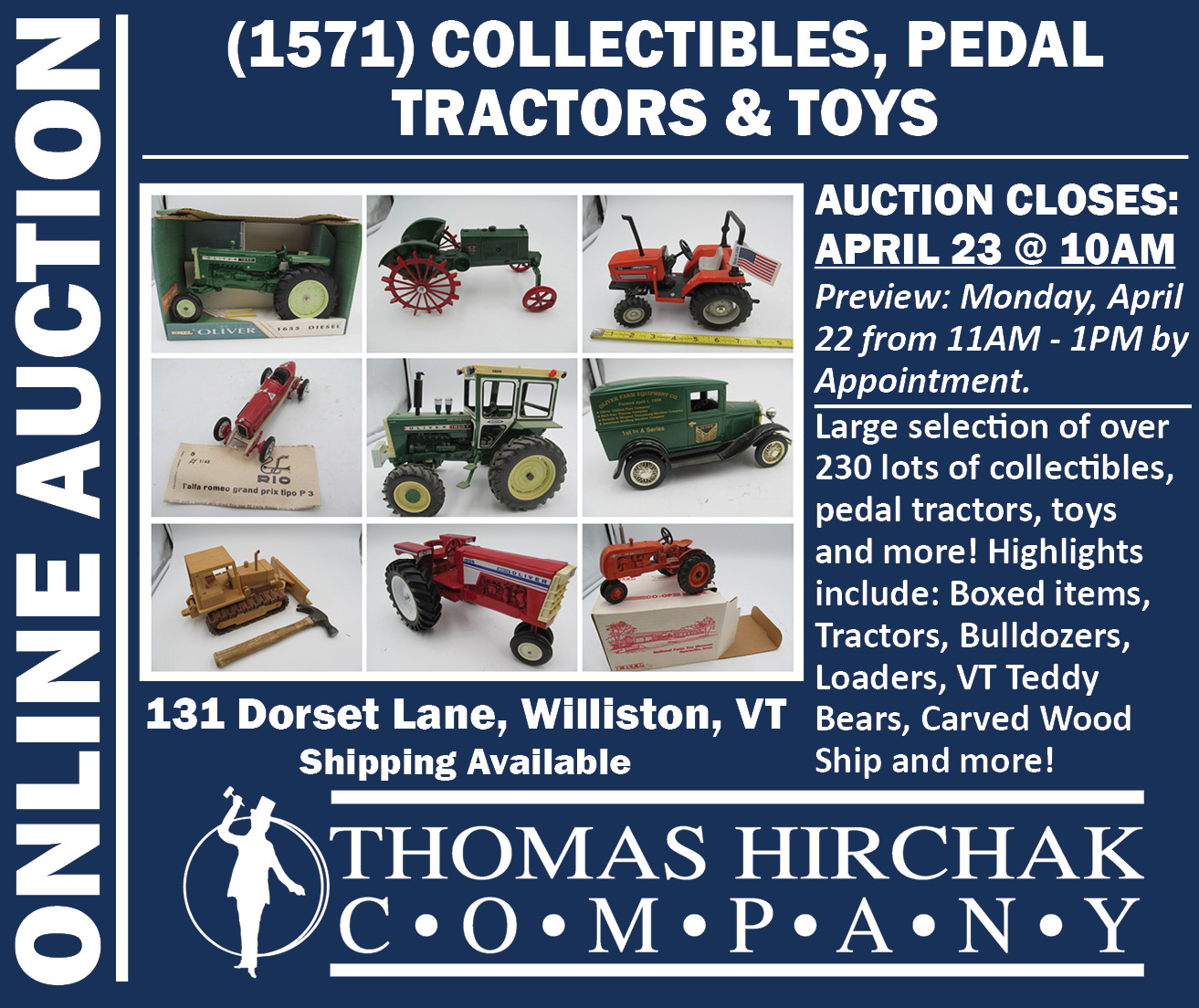Skinner's Americana Sale
March 1st, 2015
|
The Phillips family needlework, created around 1670 in the English style by 13-year-old Sarah Phillips (1656-1707) of Rowley, Massachusetts, sold for $903,000 to dealer David A. Schorsch, bidding in the gallery for a client. The price is the third-highest achieved at auction for an American needlework.
“The Bloody Massacre perpetrated in King Street, BOSTON, on March 5th 1770, by a party of the 29th Regt,” an 11¼" x 9 5/8" hand-colored illustration, engraved, printed, and sold by Paul Revere (Clarence S. Brigham, plate 14), went to a collector on the phone for $135,000. Revere’s images of the event were based altogether too closely on an earlier one by Henry Pelham, but Revere got his into distribution first, and that was that. Fewer than 20 are known to exist today, one of which was sold at Skinner many years ago. The engraving had belonged to John Fremont Hill, governor of Maine 1901-05, and descended in the family. How Hill came to acquire it is unknown.
A set of gold and applewood earrings and a brooch in the form of acorns and oak leaves by Browne & Spaulding of New York has a Civil War provenance. It went to a phone bidder for $30,750 (est. $5000/7000). The acorns were apparently carved from wood of a tree at Appomattox, where Lee and Grant negotiated the end of the war. The set included the original box, a Browne & Spaulding trade card, and an 1865 letter to William Cullen Bryant from the firm asking him to accept the jewelry as “a trifling specimen of our art” and as a memorial to the end of the Civil War. A larger set was made for U.S. Grant’s wife. Photo courtesy Skinner.
The 9½" x 14½" watercolor portrait of a young family—father, mother, and baby—seated at a grain-painted table, and a calico cat on the patterned rug beneath the table, circa 1830, by Joseph H. Davis (1811-1865), who lived and worked in Maine and New Hampshire, went to a phone bidder for $44,280. Atop the table are a book, a sheaf of documents, two quill pens, and a basket of flowers. A banjo clock hangs above the table. The painting, in its vividly painted original frame, came to Skinner on an appraisal day.
The distinctive wool needlework pocketbook was made in an Irish or bargello stitch in yarns of every color with a band embroidered “John Stevens jun.r November 19 1774.” A large silver clasp was engraved with floral elements. The pocketbook sold online for $11,070. Two possibilities exist as to the identity of the owner: John Stevens Jr., of Perth Amboy, New Jersey, or John Stevens III, treasurer of New Jersey. After he hammered it down, auctioneer and Skinner chairman Steve Fletcher recounted the occasion in his youth when he spotted two such pocketbooks in an antiques shop. He asked the price, and the cigar-chomping proprietor asked him, “Gotta girlfriend?” “Two!” replied Fletcher blandly, eying the two pocketbooks. “A buck apiece,” replied the dealer, and the deal was done.
A small, 4¾" x 5" x 3¾", paint-decorated poplar documents box with dovetailed construction was attributed to the Compasswork Decorator, also known as the Compass Artist, of Lancaster County, Pennsylvania, 1800-40. It sold in the gallery for $23,370 to an agent bidding for a client. Photo courtesy Skinner.
The very large, 77" long, “Halley’s Comet” sheet copper weathervane in the form of a six-pointed star with a trailing tail, made between 1840 and 1850, and mounted on an iron rod, was originally on the First Presbyterian Church in Jim Thorpe, Pennsylvania. It sold online for $24,600. |
Boston, Massachusetts
The Phillips family needlework, created around 1670 by Sarah Phillips (1656-1707) of Rowley, Massachusetts, is an artistic and historical tour de force. Phillips made it when she was 13 and a student at a Boston boarding school. It came to market at Skinner’s Americana sale on March 1 in Boston where it sold for $903,000 (includes buyer’s premium) to dealer David A. Schorsch in the gallery on the phone with a client. It was estimated at $800,000/1.2 million. An English-style pictorial work with biblical references, it depicted a tree of life, a couple, the prodigal son, a recumbent lion in the lower left corner, a shepherd and his flock in the right corner, birds, animals, insects, and a brick building. It was executed on blue-green linen, in red, blue, yellow, black, and white wool with silver and gold metallic thread and mica (for the window of the brick building). It was, as the catalog notes indicated, “in a remarkable state of preservation,” its colors fresh, and it showed highly skilled stitchery.
The picture’s descent, sometimes laterally, in the Phillips family is well documented, and it appears to have been highly valued by each generation. It was described as a Rowley town “relic” and attracted much attention when it was exhibited in 1839 at the celebration of the Rowley bicentennial. It was also exhibited at the Museum of Fine Arts, Boston, in the winters of 1945 and 1946.
Another textile of interest was a rare Kentucky needlework, 21¼" x 14½", by Eliza Davis of Montgomery County, that she worked in wool thread on linen. It had five bands of alphabets above a cartouche with a verse and her name and the date March 12, 1839. It sold on the phone for $11,070 (est. $800/1200). Lowell, Massachusetts, schoolgirl Sarah Colburn’s 1836 rug, 33" x 69", decorated with an eagle and shield with a banner, two baskets of flowers, and other flowers, went to a phone bidder for $8610.
Another textile lot was an 18th-century English woven wool fragment, 13" x 24", that was most likely part of a larger piece and was decorated with an appliqué basket, flowers, and leaves. It sold online for $3690 (est. $1500/2500). The consignor purchased the fragment in the 1990s at a house sale in England.
While prices were for the most part robust, seating was plentiful in the gallery. Of 344 lots, 214 sold online, and the sale was 94% sold. By the end of the sale, two people remained in the gallery.
Joseph H. Davis’s unsigned watercolor portrait of Mary Stevens depicted the sitter at a grain-painted table below a framed memorial to David Stevens. It sold online for $3198. The painting was inscribed “Mary Stevens, Aged 59 Years October 9, 1837” above a verse.
Among several portraits of American paddle-wheelers and side-wheelers, an unsigned portrait of the paddle-wheel steamer Ansonia, 24" x 32", sold in the room for $15,990 (est. $4000/6000).
An unsigned watercolor and gouache portrait of the side-wheeler Harlem, 15½" x 25¾", with a border of metallic paint, had some losses but sold for $11,685 (est. $1500/2500). An unsigned oil on canvas portrait of the paddle-wheel steamer Natchez, 22" x 38", went to a phone buyer for $6150.
An oil on canvas half-length portrait of Susannah Linzee Inman Livingston, 30" x 25", was attributed to Thomas Sully (1783-1872) and went to a left bid for $11,070.
An 1872 seascape oil on paper laid on board, 3½" x 7½", possibly of Buzzards Bay, Massachusetts, by Charles Henry Gifford (1839-1904) was estimated conservatively at $800/1200 and realized $6765.
The sale offered a selection of portrait miniatures, the highlight of which was by Joseph Veyrier (active Philadelphia 1813-17). The signed and dated 1814 watercolor on ivory portrait of a woman in a white dress with a bright red shawl, 2¾" x 2¼", in a beaded gold frame, was estimated at $800/1200 and sold on the phone for $6150. A watercolor on ivory portrait, 1¾" x 1¼", of a curly haired woman in blue was attributed to artist and goldsmith John Ramage (1748-1802), who was active in Ireland, Canada, and the U.S. In a gold pendant frame with chased designs, the portrait brought $3690 from the same phone bidder.
A 5¾" x 4½" oil on copper portrait miniature of Washington as colonel of the First Virginia Regiment, after Charles Willson Peale (1741-1827), sailed past its estimate of $4000/6000 to $9225 from a phone bidder. But it wasn’t a great day for George’s grapes when a circa 1792 wine bottle with a label inscribed “Washington Wine Imported in 1792 Rebottled in 1840” that was estimated at $10,000/15,000 did not sell—perhaps because only sediment remained inside the sealed bottle.
An Abraham Lincoln pinback campaign button featuring a 2 5/8" x 2 1/8" ambrotype photograph by Mathew Brady (1822-1896) sold online for $9225 (est. $4000/6000). The image is of a youthful Lincoln with no beard and is known as the “Cooper Union” portrait; Brady took it on February 27, 1860, when Lincoln gave an address there.
A 6" x 16 1/8" x 7½" box, carved with vines and leaves, inlaid with native and exotic woods, and with applied stars on the lid and an applied horse, stag, and dog on the front, contained 197 carved and identified wood samples and eight small butter molds. Despite some losses, it sold to a left bid for $7380 (est. $800/1200). The carver was George William Griswold (1861-1927) of Manomet, Massachusetts, who was born in Halifax, Nova Scotia, and who trained as a woodcarver and cabinetmaker in Boston.
A painted pine Noah’s ark, 17" x 28" x 8¼", that had about 180 carved and painted animals and four human figures sold on the phone for $12,300. It was thought to have been made in Germany around 1880. The same phone bidder paid $10,455 for a miniature pine six-board chest, 8¾" x 20" x 11", that was carved on the front with fans, pinwheels, notches, and a heart above the initials “ME,” all decoratively painted. An early 19th-century New England painted wall box, 10" x 14" x 7", with an arched back in red paint with green borders and yellow pinstriping and lettered “LP,” sold on the phone for $4613 (est. $800/1200).
Bidders particularly liked a mid-19th-century storage box (13" x 30¾" x 13½") that might have been overlooked except for its vibrant green and brown paint in a sponged fan pattern. Estimated at $600/800, it brought $4613.
An early 19th-century American double-sided tavern sign (58½" x 25") with iron hangers had on one side an image of a Native American in a feathered headdress holding a bow and arrow above the legend “Johnson,” and on the other side a landscape and “Johnson.” It realized $15,990.
A group of English mochaware included a rare creamware covered bowl, made between 1800 and 1825, with an engine-turned body and applied handles, that sold on the phone for $4305, just above the high estimate. But an early 19th-century creamware footed goblet (4 3/8" high) was nearly quadruple the low estimate at $2706.
Three mid-19th-century Newport, Rhode Island, half-plate daguerreotypes sold. An image of a winter procession of white-robed Jewish leaders, riding in a horse-drawn sleigh in a congested street, sold to a dealer in the room who was buying for a client. He paid $11,685 (est. $2000/4000). A view of the entrance to the Touro Cemetery in Newport sold online for $7995 (est. $1500/2500). The third image was of a stone building and uniformed guard and sold for $3383, just above the low estimate. The interior of the case was inscribed “Williams / Daguerrian Gallery,” which was located on Thames Street in Newport.
A Boston Chippendale mahogany side chair, with carving possibly by John Welch (1711-1789), sold online for $28,290. Another chair of interest was an upholstered mahogany lolling chair, circa 1800, attributed to Joseph Short of Newburyport, Massachusetts. With a serpentine crest and half-serpentine arms, square front legs, and raked rear legs, it sold for $9225 (est. $4000/6000).
A tiger maple high chest of drawers, 82" x 37½" x 20", likely made in Massachusetts between 1740 and 1760, with three small drawers over three large drawers and a single drawer over three smaller ones, had been refinished and sold online for $11,070.
Eight New York carved mahogany side chairs, made around 1810-20, with splats carved with rosettes, bosses, and reeds and with incurvate, paneled, and hairy legs on paw feet, went to a phone buyer for $9225. Fancy fared less well. Six Boston Classical mahogany chairs (one armchair, five side chairs), made between 1820 and 1825, the tablets and splats carved with sprays of foliage and scrolls, and with turned and carved front legs, went to a bidder in the gallery for $3444 (est. $4000/6000).
 A mahogany and mahogany veneer Grecian couch, 1815-30, on a scrolling frame carved with rosettes and scrolled and winged paw feet, possibly made in New York, pleasantly surprised when it sold for $4920 (est. $1000/2000). Another probable New York piece was a Federal mahogany window seat, also with a scrolling frame, that made $5535 (est. $800/1200).
A mahogany and mahogany veneer Grecian couch, 1815-30, on a scrolling frame carved with rosettes and scrolled and winged paw feet, possibly made in New York, pleasantly surprised when it sold for $4920 (est. $1000/2000). Another probable New York piece was a Federal mahogany window seat, also with a scrolling frame, that made $5535 (est. $800/1200).
A Boston Federal mahogany and mahogany veneer table, 1815-20, 29" x 21¾" x 36", with a concave apron, down-swept legs, and an old surface, was attributed to Thomas Seymour and sold to a phone bidder for $5843 (est. $800/1200).
A couple of clocks also brought good results.
For more information, go to (www.skinnerinc.com) or call (508) 970-3200.
|
|
|
|
|
|
|
|
|
|
Originally published in the June 2015 issue of Maine Antique Digest. © 2015 Maine Antique Digest




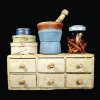



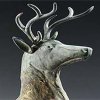










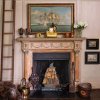







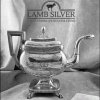
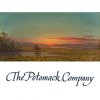

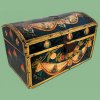


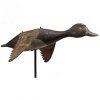

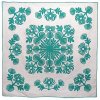






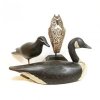

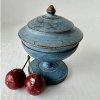
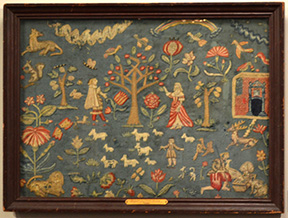
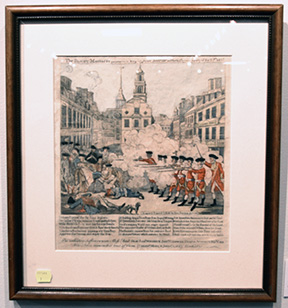
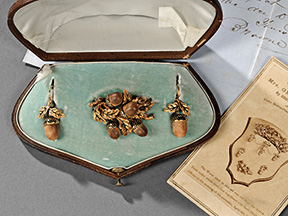
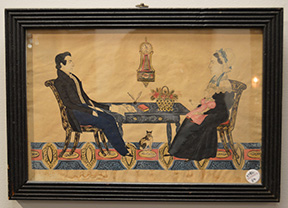
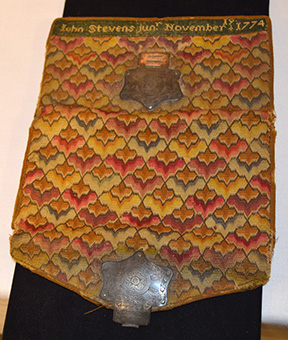
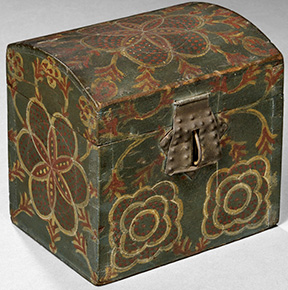
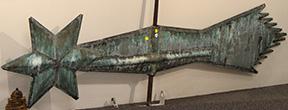
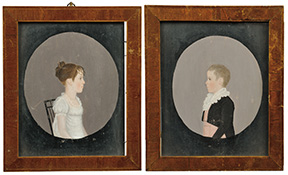 The circa 1812 pair of portraits of the children of General William Ross were unsigned but attributed to a Mr. Boyd of Wilkes-Barre, Pennsylvania, and sold to a phone bidder for $19,680. The girl in a white gown was identified as Caroline Ann Ross (Atherton), born Feb. 24, 1797, and died Aug. 18, 1885; the boy in a black overcoat with a patterned pink vest was identified on an old attached note as William Sterling Ross, born Aug. 11, 1802, and died July 11, 1868. They were painted in oil on wood. The boy, like his father, became a brigadier general and an influential Pennsylvania politician and businessman. The pictures had resided in a drawer in the consignor’s home for many years, and their condition was exceptional. Photo courtesy Skinner.
The circa 1812 pair of portraits of the children of General William Ross were unsigned but attributed to a Mr. Boyd of Wilkes-Barre, Pennsylvania, and sold to a phone bidder for $19,680. The girl in a white gown was identified as Caroline Ann Ross (Atherton), born Feb. 24, 1797, and died Aug. 18, 1885; the boy in a black overcoat with a patterned pink vest was identified on an old attached note as William Sterling Ross, born Aug. 11, 1802, and died July 11, 1868. They were painted in oil on wood. The boy, like his father, became a brigadier general and an influential Pennsylvania politician and businessman. The pictures had resided in a drawer in the consignor’s home for many years, and their condition was exceptional. Photo courtesy Skinner. The 94½" high mahogany tall-case clock, with inlaid stringing and crossbanding, brass stop-fluting on the hood and waist columns, and a painted and gilt dial with a rocking ship, was signed “J Gooding / New Bedford” and dates between 1807 and 1810. Clockmaker Joseph Gooding (1773-1853) of Dighton trained with John Bailey II and in turn trained his four brothers, Josiah (b. 1777), John (b. 1780), Henry (b. 1785), and Alanson (b. 1789). The clock went to a collector for $22,140.
The 94½" high mahogany tall-case clock, with inlaid stringing and crossbanding, brass stop-fluting on the hood and waist columns, and a painted and gilt dial with a rocking ship, was signed “J Gooding / New Bedford” and dates between 1807 and 1810. Clockmaker Joseph Gooding (1773-1853) of Dighton trained with John Bailey II and in turn trained his four brothers, Josiah (b. 1777), John (b. 1780), Henry (b. 1785), and Alanson (b. 1789). The clock went to a collector for $22,140. The carved and painted tobacconist figure of an Indian princess, 79" high, attributed to Thomas V. Brooks of Chicago and New York, sold on the phone for $20,910, just above the low estimate.
The carved and painted tobacconist figure of an Indian princess, 79" high, attributed to Thomas V. Brooks of Chicago and New York, sold on the phone for $20,910, just above the low estimate.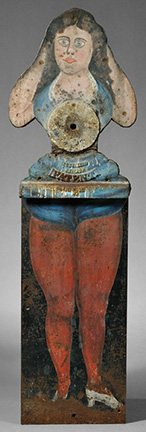 She was large (63" x 19") and voluptuous. The late 19th- or early 20th-century cast-iron female form shooting gallery target by William Wurfflein’s Quaker City Arms and
She was large (63" x 19") and voluptuous. The late 19th- or early 20th-century cast-iron female form shooting gallery target by William Wurfflein’s Quaker City Arms and 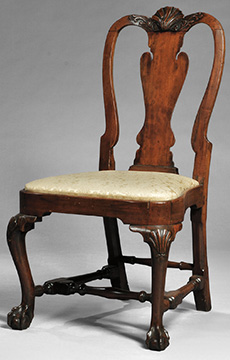 The furniture highlight was a Boston Chippendale mahogany side chair that may have been carved by John Welch (1711-1789). It has shell and acanthus leaf carving centering the serpentine crest, a compass seat, shell- and pendant-carved legs, and ball-and-claw feet. It is 39½" high overall with a seat height of 18". Estimated at $4000/6000, the chair sold online to a collector for $28,290. The chair was sold by Israel Sack to William H. Coburn of Boston in the 1970s and was acquired in the 1970s by the consignor. In the gallery walk two days before the auction, Steve Fletcher noted that the consignor, who is downsizing, paid $14,500, three times the estimate, in the early 1970s and understood that the chair was unlikely to bring such a return this time out. Instead, the result was a happy surprise. Photo courtesy Skinner.
The furniture highlight was a Boston Chippendale mahogany side chair that may have been carved by John Welch (1711-1789). It has shell and acanthus leaf carving centering the serpentine crest, a compass seat, shell- and pendant-carved legs, and ball-and-claw feet. It is 39½" high overall with a seat height of 18". Estimated at $4000/6000, the chair sold online to a collector for $28,290. The chair was sold by Israel Sack to William H. Coburn of Boston in the 1970s and was acquired in the 1970s by the consignor. In the gallery walk two days before the auction, Steve Fletcher noted that the consignor, who is downsizing, paid $14,500, three times the estimate, in the early 1970s and understood that the chair was unlikely to bring such a return this time out. Instead, the result was a happy surprise. Photo courtesy Skinner.
